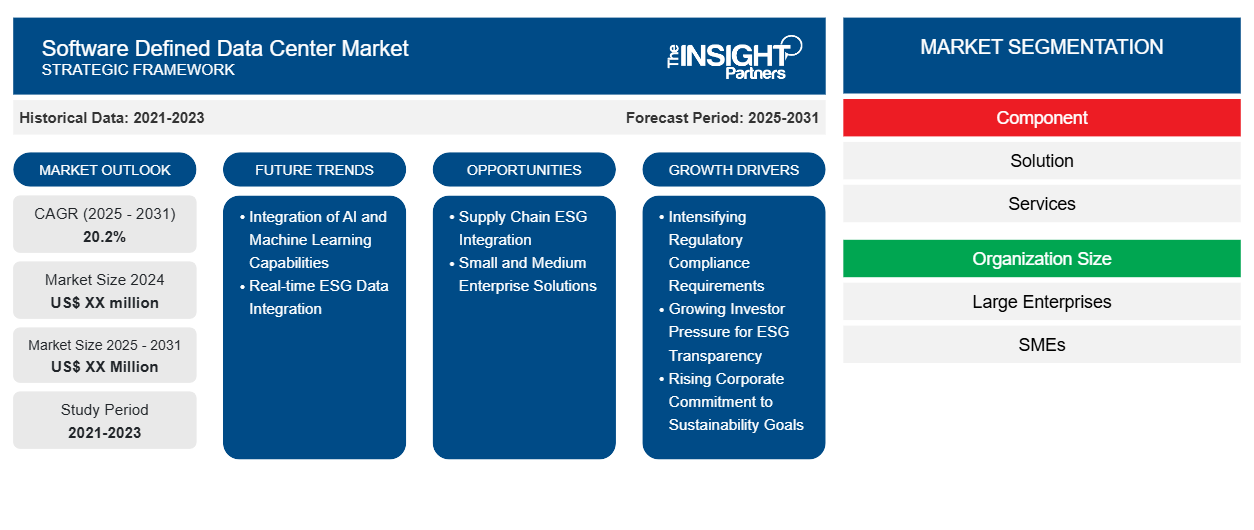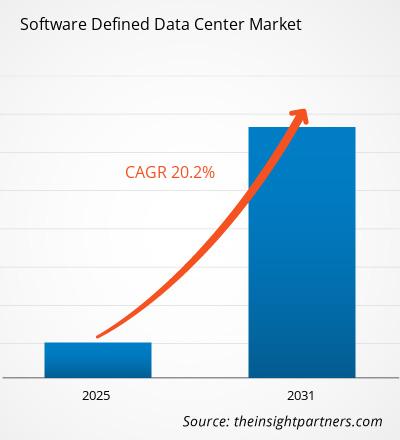Se espera que el mercado de centros de datos definidos por software registre una CAGR del 20,2 % entre 2025 y 2031, y que el tamaño del mercado se expanda de US$ XX millones en 2024 a US$ XX millones en 2031.
El informe está segmentado por componente (solución, servicios); tamaño de la organización (grandes empresas, pymes); usuarios finales (empresas, proveedores de servicios de telecomunicaciones, proveedores de servicios en la nube, proveedores de servicios gestionados). El análisis global se desglosa a nivel regional y por países principales. El informe ofrece el valor en USD para el análisis y los segmentos mencionados.
Propósito del Informe
El informe "Mercado de Centros de Datos Definidos por Software" de The Insight Partners busca describir el panorama actual y el crecimiento futuro, los principales factores impulsores, los desafíos y las oportunidades. Esto proporcionará información a diversas partes interesadas del negocio, como:
- Proveedores/fabricantes de tecnología: Para comprender la dinámica cambiante del mercado y conocer las oportunidades potenciales de crecimiento, lo que les permitirá tomar decisiones estratégicas informadas.
- Inversores: Realizar un análisis exhaustivo de tendencias respecto a la tasa de crecimiento del mercado, las proyecciones financieras del mercado y las oportunidades que existen en toda la cadena de valor.
- Órganos reguladores: Regular las políticas y las actividades policiales en el mercado con el objetivo de minimizar el abuso, preservar la confianza de los inversores y defender la integridad y estabilidad del mercado.
Segmentación del mercado de centros de datos definidos por software
Componente
- Solución
- Servicios
Tamaño de la organización
- Grandes empresas
- PYMES
Usuarios finales
- Empresas
- Proveedores de servicios de telecomunicaciones
- Proveedores de servicios en la nube
- Proveedores de servicios gestionados
Geografía
- América del norte
- Europa
- Asia Pacífico
- Oriente Medio y África
- América del Sur y Central
Obtendrá personalización en cualquier informe, sin cargo, incluidas partes de este informe o análisis a nivel de país, paquete de datos de Excel, así como también grandes ofertas y descuentos para empresas emergentes y universidades.
Mercado de centros de datos definidos por software: perspectivas estratégicas

- Obtenga las principales tendencias clave del mercado de este informe.Esta muestra GRATUITA incluirá análisis de datos, desde tendencias del mercado hasta estimaciones y pronósticos.
Factores que impulsan el crecimiento del mercado de centros de datos definidos por software
- Requisitos de Cumplimiento Regulatorio Intensificados: El panorama regulatorio global para la elaboración de informes ESG es cada vez más complejo y estricto. Nuevas regulaciones, como la CSRD de la UE, las normas de divulgación climática de la SEC y diversos mandatos nacionales, obligan a las organizaciones a adoptar soluciones de informes sofisticadas. El software de informes ESG proporciona comprobaciones de cumplimiento automatizadas, marcos estandarizados y documentación lista para auditoría para cumplir con estos requisitos en constante evolución. La capacidad del software para seguir simultáneamente múltiples estándares de informes, a la vez que garantiza la precisión y la coherencia de los datos en diferentes jurisdicciones, lo hace esencial para las organizaciones que operan en múltiples entornos regulatorios.
- Creciente presión de los inversores para la transparencia ESG: Los inversores institucionales y las partes interesadas exigen mayor transparencia y granularidad en la divulgación de información ESG. Las organizaciones necesitan soluciones de software robustas para recopilar, verificar y reportar métricas ESG que satisfagan los requisitos de diligencia debida de los inversores. El software permite a las empresas proporcionar datos detallados sobre el desempeño de sostenibilidad, evaluaciones de impacto y seguimiento del progreso hacia los objetivos ESG. Esta capacidad es especialmente crucial para las empresas que cotizan en bolsa y quienes buscan financiación sostenible, ya que los inversores integran cada vez más el desempeño ESG en sus decisiones de inversión.
- Creciente compromiso corporativo con los objetivos de sostenibilidad: Las organizaciones se están fijando ambiciosos objetivos de sostenibilidad y necesitan herramientas sofisticadas para monitorear e informar su progreso. El software de informes ESG permite monitorear en tiempo real el impacto ambiental, las iniciativas sociales y las prácticas de gobernanza. Estas plataformas permiten a las empresas medir las emisiones de carbono, monitorizar el consumo de recursos, supervisar la sostenibilidad de la cadena de suministro y evaluar las métricas de impacto social. Las capacidades analíticas del software ayudan a las organizaciones a identificar áreas de mejora y a demostrar un progreso tangible hacia sus compromisos de sostenibilidad.
Tendencias futuras del mercado de centros de datos definidos por software
- Integración de capacidades de IA y aprendizaje automático: Las plataformas de informes ESG incorporan cada vez más IA y aprendizaje automático para optimizar la recopilación, el análisis y la generación de informes de datos. Estas tecnologías permiten la extracción automatizada de datos de diversas fuentes, la detección de anomalías en las métricas ESG y el análisis predictivo del rendimiento en sostenibilidad. Las funciones basadas en IA ayudan a las organizaciones a identificar tendencias, prever impactos y generar informes de sostenibilidad más precisos, a la vez que reducen el esfuerzo manual y los posibles errores humanos.
- Integración de datos ESG en tiempo real: El mercado está evolucionando hacia capacidades de recopilación y generación de informes de datos ESG en tiempo real. Las organizaciones exigen plataformas que permitan monitorizar y actualizar continuamente las métricas ESG, en lugar de depender de actualizaciones manuales periódicas. Esta tendencia se debe a la necesidad de una toma de decisiones más oportuna y una comunicación más rápida con las partes interesadas sobre el desempeño ESG. El monitorizado en tiempo real permite la identificación inmediata de problemas y una respuesta más rápida a los retos de sostenibilidad.
Oportunidades de mercado de los centros de datos definidos por software
- Integración ESG en la cadena de suministro: Existe una gran oportunidad para que el software de informes ESG se expanda al monitoreo de la sostenibilidad de la cadena de suministro. Las organizaciones necesitan herramientas para monitorear e informar sobre el desempeño ESG de sus proveedores, garantizando así el cumplimiento de los estándares de sostenibilidad en toda su cadena de valor. Las plataformas de software pueden facilitar las evaluaciones de proveedores, monitorear las certificaciones de sostenibilidad y agregar datos ESG en toda la red de suministro, lo que permite generar informes completos sobre las emisiones de alcance 3 y otros impactos indirectos.
- Soluciones para pequeñas y medianas empresas: El segmento de las pymes presenta una creciente oportunidad para soluciones de informes ESG simplificadas y rentables. A medida que los requisitos de informes de sostenibilidad se extienden a las organizaciones más pequeñas, aumenta la demanda de plataformas optimizadas que ofrezcan capacidades esenciales de generación de informes sin la complejidad de las soluciones a escala empresarial. Los proveedores de software pueden desarrollar soluciones especializadas que ayuden a las pymes a cumplir con los requisitos básicos de informes a un precio asequible.
Perspectivas regionales del mercado de centros de datos definidos por software
Los analistas de The Insight Partners han explicado detalladamente las tendencias y los factores regionales que influyen en el mercado de centros de datos definidos por software durante el período de pronóstico. Esta sección también analiza los segmentos y la geografía del mercado de centros de datos definidos por software en Norteamérica, Europa, Asia Pacífico, Oriente Medio y África, y Sudamérica y Centroamérica.
Alcance del informe de mercado de centros de datos definidos por software
| Atributo del informe | Detalles |
|---|---|
| Tamaño del mercado en 2024 | US$ XX millones |
| Tamaño del mercado en 2031 | US$ XX millones |
| CAGR global (2025-2031) | 20,2% |
| Datos históricos | 2021-2023 |
| Período de pronóstico | 2025-2031 |
| Segmentos cubiertos | Por componente
|
| Regiones y países cubiertos | América del norte
|
| Líderes del mercado y perfiles de empresas clave |
|
Densidad de actores del mercado de centros de datos definidos por software: comprensión de su impacto en la dinámica empresarial
El mercado de centros de datos definidos por software está creciendo rápidamente, impulsado por la creciente demanda de los usuarios finales debido a factores como la evolución de las preferencias de los consumidores, los avances tecnológicos y un mayor conocimiento de los beneficios del producto. A medida que aumenta la demanda, las empresas amplían su oferta, innovan para satisfacer las necesidades de los consumidores y aprovechan las tendencias emergentes, lo que impulsa aún más el crecimiento del mercado.

- Obtenga una descripción general de los principales actores clave del mercado de centros de datos definidos por software
Puntos clave de venta
- Cobertura integral: el informe cubre de manera integral el análisis de productos, servicios, tipos y usuarios finales del mercado de centros de datos definidos por software, proporcionando un panorama holístico.
- Análisis de expertos: el informe se compila con base en el conocimiento profundo de expertos y analistas de la industria.
- Información actualizada: El informe asegura relevancia comercial debido a su cobertura de información reciente y tendencias de datos.
- Opciones de personalización: este informe se puede personalizar para satisfacer los requisitos específicos del cliente y adaptarse adecuadamente a las estrategias comerciales.
Por lo tanto, el informe de investigación sobre el mercado de centros de datos definidos por software puede ayudar a descifrar y comprender el panorama del sector y sus perspectivas de crecimiento. Si bien existen algunas preocupaciones válidas, las ventajas generales de este informe suelen superar las desventajas.
- Análisis histórico (2 años), año base, pronóstico (7 años) con CAGR
- Análisis PEST y FODA
- Tamaño del mercado, valor/volumen: global, regional y nacional
- Industria y panorama competitivo
- Conjunto de datos de Excel
Informes recientes
Testimonios
Razón para comprar
- Toma de decisiones informada
- Comprensión de la dinámica del mercado
- Análisis competitivo
- Información sobre clientes
- Pronósticos del mercado
- Mitigación de riesgos
- Planificación estratégica
- Justificación de la inversión
- Identificación de mercados emergentes
- Mejora de las estrategias de marketing
- Impulso de la eficiencia operativa
- Alineación con las tendencias regulatorias




















 Obtenga una muestra gratuita para - Mercado de centros de datos definidos por software
Obtenga una muestra gratuita para - Mercado de centros de datos definidos por software